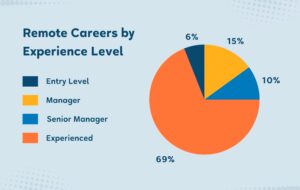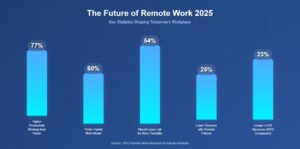The Future of Remote Work: How 2025 Will Transform the Global Workplace Forever
Remote work has evolved from a pandemic necessity to a permanent fixture of the modern workplace. As we navigate through 2025, the landscape continues to shift dramatically, driven by technological advancements, changing employee expectations, and innovative business models. This transformation isn’t just changing where we work—it’s fundamentally reshaping how we collaborate, recruit, and build company cultures.
The Current State of Remote Work in 2025 
The numbers tell a compelling story. By 2025, 32.6 million Americans will work remotely, representing a significant portion of the workforce. What’s particularly interesting is the preference patterns emerging: Gallup reports that 60% of remote-capable employees prefer a hybrid setup, 30% want to be fully remote, and less than 10% prefer to work on-site.
This data reveals a profound shift in workplace expectations. There’s a profound disconnect between business leaders ordering staff back to the office and their employees’ needs and preferences. Companies that ignore these preferences are finding themselves at a competitive disadvantage in the talent market.
What Companies Are Learning About Remote Work
The business case for remote work has become increasingly clear through 2025. Research shows that RTO firms take 23% longer to fill job vacancies, hire rates drop by 17%, and hiring costs skyrocket. Meanwhile, remote-friendly companies are thriving in the talent market and companies with remote policies boast 25% lower turnover rates.
The productivity debate has also been settled. 77% of workers think that their productivity is higher when working from home compared to a traditional office, with only 11% seeing no difference, and 12% feeling unproductive. These statistics demonstrate that the majority of remote workers are not just maintaining their productivity levels—they’re exceeding them.
However, companies implementing return-to-office mandates are experiencing significant challenges. RTO led to higher turnover among certain staff including women, highly skilled and senior tenured employees, precisely the talent organizations can least afford to lose.
The Rise of Hybrid Work Models
In 2025, hybrid work models that combine remote and in-office work are expected to become standard for many organizations. This approach represents a middle ground that addresses both employee preferences and business needs.
The data supports this trend: 72% of hybrid employees — working from home most or some of the time — prefer a hybrid arrangement. In comparison, only 24% said they’d work from home all the time. This suggests that while employees value flexibility, they also recognize the benefits of occasional in-person collaboration.
Hybrid models are particularly attractive because they allow companies to balance the benefits of remote work with the collaborative advantages of in-person interactions. Organizations are discovering that certain activities—like strategic planning, team building, and creative brainstorming—benefit from face-to-face interaction, while focused individual work often thrives in remote environments.
Technology’s Role in Shaping Remote Work’s Future
Artificial Intelligence is becoming a game-changer for remote work environments. AI-powered virtual assistants may become commonplace, assisting with scheduling, data analysis, and even basic decision-making processes. This technological integration is making remote work more efficient and productive than ever before.
AI communication tools are revolutionizing how remote teams interact, while advanced project management platforms are providing unprecedented transparency and coordination capabilities. These tools are addressing one of the primary challenges of remote work: maintaining effective communication and collaboration across distributed teams.
The implications extend beyond just productivity gains. The work week will likely be cut to 3.5 days within 15 years due to AI, according to industry experts. This prediction suggests that AI’s impact on remote work will be transformative, potentially reshaping our entire concept of the traditional work week.
Global Talent Access and Geographic Flexibility
One of the most significant advantages of remote work is the ability to access global talent pools. Companies are no longer limited by geographic boundaries when recruiting, leading to more diverse and skilled teams. This trend is particularly beneficial for organizations in competitive markets or specialized industries where local talent may be scarce.
The geographic flexibility also benefits employees, who can now live in areas with lower costs of living while earning salaries from high-paying markets. This shift is causing significant demographic changes, with people moving away from expensive urban centers to smaller cities and rural areas.
Challenges and Solutions in Remote Work
Despite its many advantages, remote work isn’t without challenges. Companies are investing heavily in digital infrastructure, cybersecurity, and employee training to ensure remote operations run smoothly. The key challenges include:
Maintaining Company Culture: Organizations are finding creative ways to preserve their culture through virtual events, online team-building activities, and regular video check-ins. The focus has shifted from location-based culture to values-based culture.
Employee Engagement and Mental Health: Remote work can sometimes lead to isolation and burnout. Companies are addressing this by providing mental health resources, encouraging regular breaks, and creating virtual social spaces for informal interactions.
Performance Management: Traditional management styles based on physical presence are evolving. Companies are adopting results-oriented management approaches that focus on outcomes rather than hours worked or physical presence.
Technology and Security: With employees working from various locations, organizations are investing in robust cybersecurity measures and providing employees with proper equipment and training.
The Economic Impact of Remote Work
The economic implications of remote work extend far beyond individual companies. Entire industries are adapting to this new reality. Commercial real estate markets are experiencing significant shifts as companies downsize their office spaces. Meanwhile, residential markets in smaller cities are booming as remote workers seek more affordable living options.
The gig economy is also thriving in this environment. Many professionals are choosing freelance or contract work over traditional employment, valuing the flexibility that comes with remote work arrangements. This trend is creating new opportunities for specialized skills and project-based work.
Industry-Specific Adaptations
Different industries are adapting to remote work in unique ways:
Technology: Tech companies were early adopters and continue to lead in remote work innovations. Many have embraced fully distributed teams and asynchronous work models.
Finance: The financial sector, traditionally conservative about remote work, has embraced hybrid models while maintaining strict security protocols for sensitive data.
Healthcare: While patient care requires physical presence, administrative functions, telemedicine, and research activities have successfully transitioned to remote work.
Education: The education sector has developed sophisticated online learning platforms and remote teaching methodologies that extend beyond emergency pandemic measures.
Looking Ahead: What to Expect by 2030
The future of remote work looks increasingly sophisticated and integrated. Several trends are emerging that will shape the next five years:
Virtual and Augmented Reality: These technologies will make remote collaboration more immersive and effective, potentially bridging the gap between remote and in-person interactions.
Advanced AI Integration: AI will become more sophisticated in supporting remote workers, from intelligent scheduling systems to AI-powered project management and decision support tools.
Results-Only Work Environments (ROWE): More companies will adopt completely flexible approaches where employees are evaluated solely on results rather than hours worked or location.
Improved Digital Wellness: As remote work matures, there will be greater focus on digital wellness, with companies providing better support for work-life balance in remote environments.
Preparing for the Future of Work
Organizations and individuals need to prepare for this evolving landscape:
For Companies:
- Invest in robust digital infrastructure and cybersecurity
- Develop remote-first policies and procedures
- Train managers to lead remote and hybrid teams effectively
- Create systems for maintaining company culture in distributed environments
- Implement results-based performance management systems
For Employees:
- Develop strong self-management and time management skills
- Improve digital communication abilities
- Create productive home office environments
- Build networks and relationships in virtual settings
- Stay current with relevant technologies and tools
The Flexibility Factor: Why It Matters 
54% of employees would leave their job for more flexible hours, highlighting that flexibility has become a top priority for today’s workforce. This isn’t just about working from home—it’s about having control over when, where, and how work gets done.
Companies that understand this are seeing significant benefits in recruitment, retention, and employee satisfaction. The organizations that will thrive in the future are those that view flexibility not as a concession to employees, but as a strategic advantage in building high-performing, engaged teams.
Building Sustainable Remote Work Cultures
The most successful remote-first companies are those that have intentionally designed their cultures for distributed work. This involves:
Clear Communication Protocols: Establishing when and how different types of communication should occur, from quick chat messages to formal video meetings.
Documented Processes: Creating comprehensive documentation that allows team members to work independently without constant guidance.
Inclusive Practices: Ensuring that remote employees have equal opportunities for participation, advancement, and recognition.
Regular Feedback Loops: Implementing systems for continuous feedback and improvement in remote work practices.
Conclusion: Embracing the Future
The future of remote work is not just about technology or policy changes—it’s about fundamentally rethinking how we approach work itself. By 2025, advancements in technology, shifts in workforce demographics, and innovative business models are converging to create a workplace that is more flexible, dynamic, and globally integrated.
The data overwhelmingly supports the continuation and expansion of remote work options. Companies that resist this trend are finding themselves at a competitive disadvantage, while those that embrace it are seeing improvements in productivity, employee satisfaction, and business outcomes.
As we move forward, the question isn’t whether remote work will continue—it’s how quickly organizations can adapt to maximize its benefits. The future belongs to companies and individuals who can harness the power of distributed work to create more effective, inclusive, and sustainable work environments.
The transformation is already underway. The organizations and professionals who embrace this change today will be the ones who thrive in tomorrow’s increasingly connected and flexible workplace. Remote work isn’t just the future—it’s the present reality that’s reshaping how we think about productivity, collaboration, and success in the modern economy.



